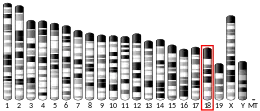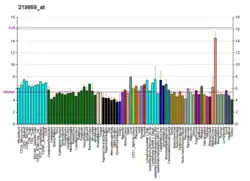MOCOS
Molybdenum cofactor sulfurase is an enzyme that in humans is encoded by the MOCOS gene.[5][6]
| MOCOS | |||||||||||||||||||||||||||||||||||||||||||||||||||
|---|---|---|---|---|---|---|---|---|---|---|---|---|---|---|---|---|---|---|---|---|---|---|---|---|---|---|---|---|---|---|---|---|---|---|---|---|---|---|---|---|---|---|---|---|---|---|---|---|---|---|---|
| Identifiers | |||||||||||||||||||||||||||||||||||||||||||||||||||
| Aliases | MOCOS, hMCS, MCS, MOS, molybdenum cofactor sulfurase | ||||||||||||||||||||||||||||||||||||||||||||||||||
| External IDs | OMIM: 613274 MGI: 1915841 HomoloGene: 9931 GeneCards: MOCOS | ||||||||||||||||||||||||||||||||||||||||||||||||||
| |||||||||||||||||||||||||||||||||||||||||||||||||||
| |||||||||||||||||||||||||||||||||||||||||||||||||||
| |||||||||||||||||||||||||||||||||||||||||||||||||||
| |||||||||||||||||||||||||||||||||||||||||||||||||||
| |||||||||||||||||||||||||||||||||||||||||||||||||||
| Wikidata | |||||||||||||||||||||||||||||||||||||||||||||||||||
| |||||||||||||||||||||||||||||||||||||||||||||||||||
MOCOS sulfurates the molybdenum cofactor of xanthine dehydrogenase (XDH) and aldehyde oxidase (AOX1), which is required for their enzymatic activities.[5]
References
- GRCh38: Ensembl release 89: ENSG00000075643 - Ensembl, May 2017
- GRCm38: Ensembl release 89: ENSMUSG00000039616 - Ensembl, May 2017
- "Human PubMed Reference:". National Center for Biotechnology Information, U.S. National Library of Medicine.
- "Mouse PubMed Reference:". National Center for Biotechnology Information, U.S. National Library of Medicine.
- Ichida K, Matsumura T, Sakuma R, Hosoya T, Nishino T (April 2001). "Mutation of human molybdenum cofactor sulfurase gene is responsible for classical xanthinuria type II". Biochemical and Biophysical Research Communications. 282 (5): 1194–200. doi:10.1006/bbrc.2001.4719. PMID 11302742.
- "Entrez Gene: MOCOS molybdenum cofactor sulfurase".
Further reading
- Maruyama K, Sugano S (January 1994). "Oligo-capping: a simple method to replace the cap structure of eukaryotic mRNAs with oligoribonucleotides". Gene. 138 (1–2): 171–4. doi:10.1016/0378-1119(94)90802-8. PMID 8125298.
- Suzuki Y, Yoshitomo-Nakagawa K, Maruyama K, Suyama A, Sugano S (October 1997). "Construction and characterization of a full length-enriched and a 5'-end-enriched cDNA library". Gene. 200 (1–2): 149–56. doi:10.1016/S0378-1119(97)00411-3. PMID 9373149.
- Yamamoto T, Moriwaki Y, Takahashi S, Tsutsumi Z, Tuneyoshi K, Matsui K, et al. (November 2003). "Identification of a new point mutation in the human molybdenum cofactor sulferase gene that is responsible for xanthinuria type II". Metabolism. 52 (11): 1501–4. doi:10.1016/s0026-0495(03)00272-5. PMID 14624414.
- Beausoleil SA, Villén J, Gerber SA, Rush J, Gygi SP (October 2006). "A probability-based approach for high-throughput protein phosphorylation analysis and site localization". Nature Biotechnology. 24 (10): 1285–92. doi:10.1038/nbt1240. PMID 16964243. S2CID 14294292.
- Peretz H, Naamati MS, Levartovsky D, Lagziel A, Shani E, Horn I, et al. (May 2007). "Identification and characterization of the first mutation (Arg776Cys) in the C-terminal domain of the Human Molybdenum Cofactor Sulfurase (HMCS) associated with type II classical xanthinuria". Molecular Genetics and Metabolism. 91 (1): 23–9. doi:10.1016/j.ymgme.2007.02.005. PMID 17368066.
This article is issued from Wikipedia. The text is licensed under Creative Commons - Attribution - Sharealike. Additional terms may apply for the media files.




